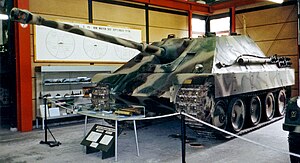Jagdpanther
| Jagdpanther | |
|---|---|

Jagdpanzer V Jagdpanther
|
|
| Type | Tank destroyer |
| Place of origin | Nazi Germany |
| Service history | |
| In service | 1944-1945 (Nazi Germany) 1945-1960s (France) |
| Production history | |
| Produced | 1944–1945 |
| No. built | 415 |
| Variants | G1, G2 |
| Specifications | |
| Weight | 45.5 tonnes (100,300 lb) |
| Length | 9.87 m (32 ft 5 in) |
| Width | 3.42 m (11 ft 3 in) |
| Height | 2.71 m (8 ft 11 in) |
| Crew | 5 |
|
|
|
| Armor | 80 mm (3.14 in) frontal 100 mm (3.93 in) mantlet 60mm side 40mm rear |
|
Main
armament |
1 × 8.8 cm Pak 43/3 or 43/4 L/71 57 rounds |
|
Secondary
armament |
1 × 7.92 mm Maschinengewehr 34 600 rounds |
| Engine |
Maybach HL230 P30 (V-12 petrol) 700 PS (690 hp, 515 kW) |
| Power/weight | 15.4 PS (11.3 kW) / tonne |
| Suspension | dual torsion bar |
|
Operational
range |
160 km (99 miles) |
| Speed | 46 km/h (28.6 mph) |
The Jagdpanther (German: "hunting panther") was a tank destroyer built by Nazi Germany during World War II based on the chassis of the Panther tank. It entered service late in the war (1944) and saw service on the Eastern and Western Fronts. The Jagdpanther combined the very powerful 8.8 cm KwK 43 cannon of the Tiger II and the characteristically excellent armor and suspension of the Panther chassis, although it suffered from the general poor state of German ordnance production, maintenance and training in the later part of the war, which resulted in small production numbers, shortage in spare parts and poor crew readiness.
The Jagdpanther had been preceded by two attempts at mounting an 8.8 cm gun as a self-propelled anti-tank weapon; Ferdinand using the 91 leftover Porsche-built VK4501(P) chassis from the Tiger tank competition it had lost to Henschel in 1942, and the Nashorn using a Panzer III/IV chassis. Ferdinand proved to be too heavy and Nashorn small and underpowered.
A heavy tank destroyer design based on the 8.8 cm Pak 43 gun and the Panther tank chassis was ordered in late 1942 as design SdKfz 173. The prototype by Mühlenbau-Industrie A.G. (MIAG) was demonstrated in October 1943 before Hitler.
Production started in January 1944; in February, Hitler specified the simpler Jagdpanther name instead of its original "8.8 cm Pak 43/3 auf Panzerjäger Panther".
To accommodate the heavier-calibre gun, much as on previous Jagdpanzer-style unturreted tank destroyers, the glacis plate and sloped hull sides of the Jagdpanther were extended up into an integral, turretless fixed casemate as part of the main hull itself to provide a roomy interior. The Jagdpanther had side armour of increased thickness (60 mm) to offset the slightly reduced angle of the side armour necessary to provide enough interior space. Frontal armour was 80mm. The new (April 1944) Panther Ausf. G had the same feature, to harmonize production and increase protection.
...
Wikipedia
